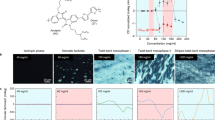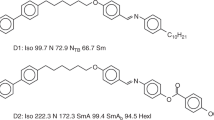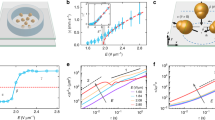Abstract
From determining the optical properties of simple molecular crystals to establishing the preferred handedness in highly complex vertebrates, molecular chirality profoundly influences the structural, mechanical and optical properties of both synthetic and biological matter on macroscopic length scales1,2. In soft materials such as amphiphilic lipids and liquid crystals, the competition between local chiral interactions and global constraints imposed by the geometry of the self-assembled structures leads to frustration and the assembly of unique materials3,4,5,6. An example of particular interest is smectic liquid crystals, where the two-dimensional layered geometry cannot support twist and chirality is consequently expelled to the edges in a manner analogous to the expulsion of a magnetic field from superconductors7,8,9,10. Here we demonstrate a consequence of this geometric frustration that leads to a new design principle for the assembly of chiral molecules. Using a model system of colloidal membranes11, we show that molecular chirality can control the interfacial tension, an important property of multi-component mixtures. This suggests an analogy between chiral twist, which is expelled to the edges of two-dimensional membranes, and amphiphilic surfactants, which are expelled to oil–water interfaces12. As with surfactants, chiral control of interfacial tension drives the formation of many polymorphic assemblages such as twisted ribbons with linear and circular topologies, starfish membranes, and double and triple helices. Tuning molecular chirality in situ allows dynamical control of line tension, which powers polymorphic transitions between various chiral structures. These findings outline a general strategy for the assembly of reconfigurable chiral materials that can easily be moved, stretched, attached to one another and transformed between multiple conformational states, thus allowing precise assembly and nanosculpting of highly dynamical and designable materials with complex topologies.
This is a preview of subscription content, access via your institution
Access options
Subscribe to this journal
Receive 51 print issues and online access
$199.00 per year
only $3.90 per issue
Buy this article
- Purchase on Springer Link
- Instant access to full article PDF
Prices may be subject to local taxes which are calculated during checkout




Similar content being viewed by others
References
Pasteur, L. On the relations that can exist between crystalline form, and chemical composition and the sense of rotary polarization. Ann. Chim. Phys. 24, 442–459 (1848)
Hirokawa, N., Tanaka, Y., Okada, Y. & Takeda, S. Nodal flow and the generation of left-right asymmetry. Cell 125, 33–45 (2006)
Harris, A. B., Kamien, R. D. & Lubensky, T. C. Molecular chirality and chiral parameters. Rev. Mod. Phys. 71, 1745–1757 (1999)
Oda, R., Huc, I., Schmutz, M., Candau, S. J. & MacKintosh, F. C. Tuning bilayer twist using chiral counterions. Nature 399, 566–569 (1999)
Aggeli, A. et al. Hierarchical self-assembly of chiral rod-like molecules as a model for peptide beta-sheet tapes, ribbons, fibrils, and fibers. Proc. Natl Acad. Sci. USA 98, 11857–11862 (2001)
Kamien, R. D. & Selinger, J. V. Order and frustration in chiral liquid crystals. J. Phys. Condens. Matter 13, R1–R22 (2001)
de Gennes, P. G. An anology between superconductors and smectics A. Solid State Commun. 88, 1039–1042 (1993)
Renn, S. R. & Lubensky, T. C. Abrikosov dislocation lattice in a model of the cholesteric to smectic-A transition. Phys. Rev. A 38, 2132–2147 (1988)
Matsumoto, E. A., Alexander, G. P. & Kamien, R. D. Helical nanofilaments and the high chirality limit of smectics A . Phys. Rev. Lett. 103, 257804 (2009)
Hough, L. E. et al. Helical nanofilament phases. Science 325, 456–460 (2009)
Barry, E. & Dogic, Z. Entropy driven self-assembly of nonamphiphilic colloidal membranes. Proc. Natl Acad. Sci. USA 107, 10348–10353 (2010)
Safran, S. Statistical Thermodynamics of Surfaces, Interfaces, and Membranes 79–85 (Addison Wesley, 1994)
Barry, E., Beller, D. & Dogic, Z. A model liquid crystalline system based on rodlike viruses with variable chirality and persistence length. Soft Matter 5, 2563–2570 (2009)
Baumgart, T., Hess, S. T. & Webb, W. W. Imaging coexisting fluid domains in biomembrane models coupling curvature and line tension. Nature 425, 821–824 (2003)
Honerkamp-Smith, A. R. et al. Line tensions, correlation lengths, and critical exponents in lipid membranes near critical points. Biophys. J. 95, 236–246 (2008)
Lee, K. Y. C. & McConnell, H. M. Quantitized symmetry of liquid monolayer domains. J. Phys. Chem. 97, 9532–9539 (1993)
Dogic, Z. & Fraden, S. Cholesteric phase in virus suspensions. Langmuir 16, 7820–7824 (2000)
Oldenbourg, R. & Mei, G. New polarized light microscope with precision universal compensator. J. Microsc. 180, 140–147 (1995)
Barry, E., Dogic, Z., Meyer, R. B., Pelcovits, R. A. & Oldenbourg, R. Direct measurement of the twist penetration length in a single smectic a layer of colloidal virus particles. J. Phys. Chem. B 113, 3910–3913 (2009)
Oldenbourg, R. Polarized light field microscopy: an analytical method using a microlens array to simultaneously capture both conoscopic and orthoscopic views of birefringent objects. J. Microsc. 231, 419–432 (2008)
Aarts, D. G. A. L., Schmidt, M. & Lekkerkerker, H. N. W. Direct visual observation of thermal capillary waves. Science 304, 847–850 (2004)
Fradin, C. et al. Reduction in the surface energy of liquid interfaces at short length scales. Nature 403, 871–874 (2000)
Pelcovits, R. A. & Meyer, R. B. Twist penetration in single-layer smectic A discs of colloidal virus particles. Liq. Cryst. 36, 1157–1160 (2009)
Kaplan, C. N., Tu, H., Pelcovits, R. A. & Meyer, R. B. Theory of depletion-induced phase transition from chiral smectic-A twisted ribbons to semi-infinite flat membranes. Phys. Rev. E 82, 021701 (2010)
Srivastava, S. et al. Light-controlled self-assembly of semiconductor nanoparticles into twisted ribbons. Science 327, 1355–1359 (2010)
Chung, W. J. et al. Biomimetic self-templating supramolecular structures. Nature 478, 364–368 (2011)
Grason, G. M. & Bruinsma, R. F. Chirality and equilibrium biopolymer bundles. Phys. Rev. Lett. 99, 098101 (2007)
Claessens, M., Semmrich, C., Ramos, L. & Bausch, A. R. Helical twist controls the thickness of F-actin bundles. Proc. Natl Acad. Sci. USA 105, 8819–8822 (2008)
Nguyen, T. D. & Glotzer, S. C. Switchable helical structures formed by the hierarchical self-assembly of laterally tethered nanorods. Small 5, 2092–2098 (2009)
Nguyen, T. D. & Glotzer, S. C. Reconfigurable assemblies of shape-changing nanorods. ACS Nano 4, 2585–2594 (2010)
Maniatis, T., Sambrook, J. & Fritsch, E. Molecular Cloning Ch. 3. (1989)
Lettinga, M. P., Barry, E. & Dogic, Z. Self-diffusion of rod-like viruses in the nematic phase. Europhys. Lett. 71, 692–698 (2005)
Tang, J. X. & Fraden, S. Nonmonotonic temperature dependence of the flexibility of bacteriophage fd. Biopolymers 39, 13–22 (1996)
Lau, A. W. C., Prasad, A. & Dogic, Z. Condensation of isolated semi-flexible filaments driven by depletion interactions. Europhys. Lett. 87, 48006 (2009)
Purdy, K. R. et al. Measuring the nematic order of suspensions of colloidal fd virus by X-ray diffraction and optical birefringence. Phys. Rev. E 67, 031708 (2003)
Mastronarde, D. N. Automated electron microscope tomography using robust prediction of specimen movements. J. Struct. Biol. 152, 36–51 (2005)
Kremer, J. R., Mastronarde, D. N. & McIntosh, J. R. Computer visualization of three-dimensional image data using IMOD. J. Struct. Biol. 116, 71–76 (1996)
Yang, Y., Barry, E., Dogic, Z. & Hagan, M. F. Self-assembly of 2D membranes from mixtures of hard rods and depleting polymers. Soft Matter 8, 707–714 (2012)
Acknowledgements
This work was supported by the US National Science Foundation (NSF-MRSEC-0820492, NSF-DMR-0955776, NSF-MRI-0923057, NSF-CMMI-1068566) and the Petroleum Research Fund (ACS-PRF 50558-DNI7). We acknowledge use of the Brandeis MRSEC optical microscopy facility.
Author information
Authors and Affiliations
Contributions
T.G., E.B., M.J.Z., R.B.M. and Z.D. designed the experiments and interpreted the results. T.G., E.B. and M.J.Z. performed the experiments. A.W. performed the optical trapping experiments. E.B., C.B. and D.N. performed the electron microscopy imaging. M.H. performed the experiments on mutant viruses. R.O. performed the LC-PolScope imaging. Y.Y. and M.F.H. designed and performed the computer simulations. T.G., E.B., M.J.Z. and Z.D. wrote the manuscript.
Corresponding author
Ethics declarations
Competing interests
The authors declare no competing financial interests.
Supplementary information
Supplementary Information
The file contains Supplementary Figures 1-9 with legends and full legends for Supplementary Movies 1-5. (PDF 10986 kb)
Supplementary Movie 1
This movie shows the reversible transition of a 2D colloidal membrane composed of fd viruses into several connected 1D twisted ribbons, induced by increasing the strength of chiral interactions between the constituent virus particles. The duration of the movie is 11.9 minutes. (MOV 8867 kb)
Supplementary Movie 2
The movie shows real-time composite phase contrast/fluorescence video of a 1D twisted ribbon reveals the dynamics of individual fluorescently labeled viruses within the ribbon. As the rods diffuse through the structure, their apparent shape changes from circular spots to elongated rods, indicating twisting. (MOV 736 kb)
Supplementary Movie 3
This movie depicts the reversible transition from 2D membranes to a 1D twisted ribbon by the application of a stretching force imparted by optical tweezers. (MOV 4223 kb)
Supplementary Movie 4
This movie illustrates the transition of a single 1D twisted ribbon into a 2D membrane by decreasing the strength of chiral interactions between the viruses. (MOV 3412 kb)
Supplementary Movie 5
The movie shows as in movie 1, a 2D membrane is transitioned into several twisted ribbons. In this movie, two of the formed ribbons anneal, altering the structure's topology and preventing the complete reformation of the 2D membrane upon reversing the transition. The duration of the movie is 14.4 minutes. (MOV 3296 kb)
Rights and permissions
About this article
Cite this article
Gibaud, T., Barry, E., Zakhary, M. et al. Reconfigurable self-assembly through chiral control of interfacial tension. Nature 481, 348–351 (2012). https://doi.org/10.1038/nature10769
Received:
Accepted:
Published:
Issue Date:
DOI: https://doi.org/10.1038/nature10769
This article is cited by
-
Flow-induced periodic chiral structures in an achiral nematic liquid crystal
Nature Communications (2024)
-
Spiral packing and chiral selectivity in model membranes probed by phase-resolved sum-frequency generation microscopy
Nature Communications (2024)
-
Thermodynamically controlled multiphase separation of heterogeneous liquid crystal colloids
Nature Communications (2023)
-
Hierarchically self-assembled homochiral helical microtoroids
Nature Nanotechnology (2022)
-
Self-assembled liquid crystal architectures for soft matter photonics
Light: Science & Applications (2022)
Comments
By submitting a comment you agree to abide by our Terms and Community Guidelines. If you find something abusive or that does not comply with our terms or guidelines please flag it as inappropriate.



